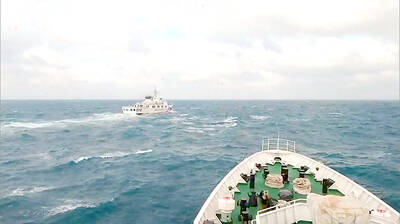The miniscule distance of 0.01 angstrom — or 10-12 meters — has helped a young Taiwanese scientist bag the science equivalent of an “Olympic gold medal” in the global race to find the shortest metal-metal bond in chemistry. The feat has also helped Taiwan gain some recognition on the international scientific stage.
The achievement, reported in the renowned magazine Science and the journal Nature, came this year when Tsai Yi-chou (蔡易州), an associate chemistry professor at National Tsing Hua University (NTHU), synthesized a stable quintuple-bonded dichromium complex (a molecule that contains two chromium atoms that has five metal-metal bonds between them).
Tsai’s discovery broke a four-decade stagnation in chemistry where scientists were previously only able to make very short quadruple-bonded metal-metal bonds, the National Science Council (NSC) said at a press conference yesterday.
Though the compound has yet to find industrial or commercial application, its academic implications are profound, the NSC said, adding that Tsai’s breakthrough was published this August in Germany’s Angewandte Chemie as well as the Journal of the American Chemical Society.
In the past century, scientists had always believed that the more bonds that exist between two atoms, the shorter the bond distance would be, Tsai said.
In 2005, a quintuple-bonded dichromium compound was synthesized by Philip Power and colleagues, but the bond distance was 1.83 angstrom, Tsai said.
“Inorganic chemists have long thought that the fewer ligands on metal atoms, the better [stronger and shorter] a quintuple-bonded compound could be made … However, we made our compound with two or three ligands attached to each of our chromium atoms and the bond distance is 1.74 angstrom,” Tsai said.
Quoting US chemist Klaus Theopold, the record would be very difficult to break, as 1.74 angstrom may very well be the limit for the shortest metal-metal bond, he said.
Though Rhett Kempe, a professor at Germany’s Bayreuth University, had also submitted a quintuple-bonded compound to Angewandte Chemie in August, his chromium-chromium bond was 1.75 angstrom, the NSC said.
“My work focuses on the chemistry of low-valent and low-coordinate [or “coordination unsaturated”] transition metal complexes,” Tsai told reporters.

Conflict with Taiwan could leave China with “massive economic disruption, catastrophic military losses, significant social unrest, and devastating sanctions,” a US think tank said in a report released on Monday. The German Marshall Fund released a report titled If China Attacks Taiwan: The Consequences for China of “Minor Conflict” and “Major War” Scenarios. The report details the “massive” economic, military, social and international costs to China in the event of a minor conflict or major war with Taiwan, estimating that the Chinese People’s Liberation Army (PLA) could sustain losses of more than half of its active-duty ground forces, including 100,000 troops. Understanding Chinese

The Ministry of Foreign Affairs (MOFA) yesterday said it is closely monitoring developments in Venezuela, and would continue to cooperate with democratic allies and work together for regional and global security, stability, and prosperity. The remarks came after the US on Saturday launched a series of airstrikes in Venezuela and kidnapped Venezuelan President Nicolas Maduro, who was later flown to New York along with his wife. The pair face US charges related to drug trafficking and alleged cooperation with gangs designated as terrorist organizations. Maduro has denied the allegations. The ministry said that it is closely monitoring the political and economic situation

UNRELENTING: China attempted cyberattacks on Taiwan’s critical infrastructure 2.63 million times per day last year, up from 1.23 million in 2023, the NSB said China’s cyberarmy has long engaged in cyberattacks against Taiwan’s critical infrastructure, employing diverse and evolving tactics, the National Security Bureau (NSB) said yesterday, adding that cyberattacks on critical energy infrastructure last year increased 10-fold compared with the previous year. The NSB yesterday released a report titled Analysis on China’s Cyber Threats to Taiwan’s Critical Infrastructure in 2025, outlining the number of cyberattacks, major tactics and hacker groups. Taiwan’s national intelligence community identified a large number of cybersecurity incidents last year, the bureau said in a statement. China’s cyberarmy last year launched an average of 2.63 million intrusion attempts per day targeting Taiwan’s critical

‘SLICING METHOD’: In the event of a blockade, the China Coast Guard would intercept Taiwanese ships while its navy would seek to deter foreign intervention China’s military drills around Taiwan this week signaled potential strategies to cut the nation off from energy supplies and foreign military assistance, a US think tank report said. The Chinese People’s Liberation Army (PLA) conducted what it called “Justice Mission 2025” exercises from Monday to Tuesday in five maritime zones and airspace around Taiwan, calling them a warning to “Taiwanese independence” forces. In a report released on Wednesday, the Institute for the Study of War said the exercises effectively simulated blocking shipping routes to major port cities, including Kaohsiung, Keelung and Hualien. Taiwan would be highly vulnerable under such a blockade, because it